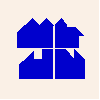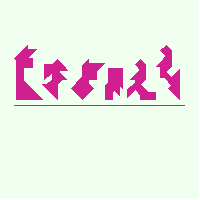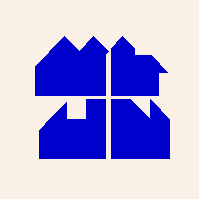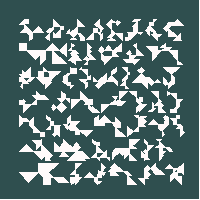FOREWORD
INTRODUCTION
CONVEX FIGURES
FULLY MATCHED PATTERNS
MISCELLANEA
HIGHLY MATCHED PATTERNS
SMALL CONVEX HULL AREA PATTERNS
COUNTING TANGRAM PATTERNS
MORE PATTERNS
WRITE ME
LINKS
|
COUNTING TANGRAM PATTERNS · In the previous sections we have exploited the set of the
fully matched
patterns.
If you are not yet bored to hear about it, you could find interesting
to know that it is countable and finite. It has, more or less, ten
millions of distinguishable elements. If you don’t trust me, read
the following. ·
Let’s build a snakelike pattern, as in the movie frames on the
left, and count how many choices should be available at each step,
neglecting the occurrence of overlap. ·
I started from the square, the choice of the first element being
unessential for counting. In the second step, we can assemble the six
remaining pieces, which reduce to four, since the two small and two
large triangles are paired, and cannot be distinguished. ·
You can match one of the four independent piece on one side of the
square. The sides of the square are undistinguishable. On the contrary,
each side of the triangles gives rise to different patterns, while only
two sides of the rhomboid can be distinguished, which double by
flipping. Therefore, there are 3 pieces x 3 sides + 1 piece x 2 sides x
2 = 13 choices. For the sake of illustration, let's chose the medium
triangle, and match it to the square, as in the reported sequence. ·
In the third step we can match the five remaining pieces (three of them
being independent, one small triangle, one large triangle and the
rhomboid) either on a side of the square or on one of the medium
triangle, with the exclusion of the two shared sides. Now, the three
free sides of the square give rise to independent configurations. ·
Therefore, there are (1 piece x 4 sides + 1 piece x 3 sides – 2
shared sides) x ( 2 pieces x 3 sides + 1 piece x 2 sides x 2) = 50
choices. We can continue in this way. ·
For the sequence reported in the table, at the end of the seven steps,
we found more than 1 billion of alternative possibilities, and exactly
13 x 50 x 42 x 48 x 27 x 30 = 1061424000 choices. ·
You can make the exercise of choosing a different sequence of pieces,
building another snakelike pattern. You will always get the same order
of magnitude of different choices, i.e. 1000000000. ·
Indeed snakelike patterns are not the rule, but the exception. In fact
many choices evolve in wrapped configurations, which should give rise
to overlapping. For instance, if you match the last large triangle as
in the last but one frame of the sequence, rather than as in the last
frame, you get a forbidden pattern, since the triangle overlaps the
rhomboid and the square. · The occurrence of overlapping pieces can be statistically checked. I did it by generating
10000 random sequences on the computer.
It randomly tries to match the pieces, checking for overlapping at each choice, and, in case, rejecting it. ·
I found that 5 choices are rejected as an average, to assemble all the
7 pieces. This event nearly halves the number of allowed choices at
each step, from the third one onward. Therefore, the number of
independent patterns turns out to be nearly 1000000000 / 25 » 30000000 (thirty millions). · A second source of reduction on the independent choices is the fact that there exist twin
and multiples configurations. They are patterns whose silhouettes are
the same, while the internal compositions are not. However, as in
mankind, twins are not the rule in the Tangram population. ·
A third source of reduction on the independent choices is the
occurrence of ring-like patterns. Such kind of configurations has not
to be counted twice. ·
As a whole, the value of ten millions of distinguishable silhouettes
seem a conservative estimate for the fully matched Tangram patterns. ·
This number is large enough to challenge Tangram players for a long
time. In fact, according to the sampling done in the previous sections,
there should exist about one million of silhouettes
looking like something,
nearly 3000 with
nine pairs of matched edges,
and about 100000 with the
convex hull area less than 1.2.
·
see more than one billion of silhouettes
>>>>>> Tangle'nTanzzle <<<<<<
|





ERRATA CORRIGE

|









